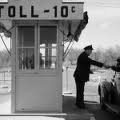 Regular readers know I have long argued that the best way to pay for the enormous cost of reconstructing and modernizing this country’s aging Interstate highway system is via what I call “value-added tolling.” That means only instituting tolling where doing so provides significant new value for those now being asked to pay tolls—such as for a brand new toll road, new toll lanes, or replacing an aging and obsolete non-tolled highway with a state-of-the-art all-electronic toll road.
Regular readers know I have long argued that the best way to pay for the enormous cost of reconstructing and modernizing this country’s aging Interstate highway system is via what I call “value-added tolling.” That means only instituting tolling where doing so provides significant new value for those now being asked to pay tolls—such as for a brand new toll road, new toll lanes, or replacing an aging and obsolete non-tolled highway with a state-of-the-art all-electronic toll road.
Unfortunately, the first of three states in the federal pilot program to reconstruct an Interstate via toll finance—Virginia—is going about it all wrong. The original plan was to create only two tolling points along the 179 miles of I-95 from the North Carolina border to the Capital Beltway near Washington, DC. That was bad enough, but this month the state scaled the plans back even further, to a single tolling point near the North Carolina border. The rationale for both plans was to hit through traffic with tolls while letting most Virginia residents avoid paying.
That approach is wrong in principle, and it is proving to be a disaster in practice, arousing even more opposition than the original plan. It’s wrong in principle because if the idea is to reconstruct and modernize I-95, that’s a benefit for everyone who uses it, not just out-of-staters. Virginia DOT estimates that I-95 needs $12.2 billion worth of reconstruction and widening over the next 25 years, but likely federal and state fuel tax funds will cover only about $2.1 billion, leaving a gap of over $10 billion. Who, if not the users, should be paying for that?
And by scaling back to a single tolling point, which happens to be in an economically depressed portion of the state, VDOT is further shooting itself in the foot. Besides foregoing most of the potential revenue, it has aroused a firestorm of opposition from local residents as well as from Republican Senate candidate (and former governor) George Allen.
VDOT has also been losing the rhetorical battle. Nearly every news story I’ve seen over the past year has adopted the trucking industry’s terminology, characterizing the state’s proposal as “installing a tolling facility on I-95 near the NC border”—rather than as a plan to pay for the otherwise unaffordable $12 billion replacement and modernization of I-95. VDOT has not set forth and publicized a complete 25-year plan to reconstruct and widen I-95, but has only provided examples of possible near-term improvements, such as rebuilding the interchange with I-85 and US 460 in Petersburg.
By contrast, the other two pilot program states have far better plans. As I’ve written before, Missouri–along with three other states–has developed a comprehensive plan to rebuild I-70 all the way from Kansas City to eastern Ohio with added truck-only lanes. And North Carolina has developed a $4.4 billion plan to widen all of I-95 there, tolling it from border to border, with electronic toll collection points every 20 miles. By contrast, two states that did not get approved for the pilot program—Connecticut and Rhode Island—seemed likely to go with border-tolling on the same politically motivated basis as Virginia.
Frankly, with the rapid emergence of all-electronic tolling, the simplest and fairest way to implement tolling to finance Interstate reconstruction and modernization is to equip only the on-ramps and off-ramps. That way, customers of the Interstate would pay for exactly the number of miles they drive—no more and no less. That model was first introduced way back in 1997 on Highway 407ETR near Toronto, and has worked well ever since. This would be a great way to pioneer mileage-based user fees on America’s most important highway system.
Let me close by quoting a few sentences of commentary from Tollroadsnews about VDOT’s revised plan:
“You have to think the Feds will be wondering whether this plan from Virginia is a serious proposal; tolls play such a small role. Since this is the last ‘slot’ in the Interstate System Reconstruction & Rehabilitation Pilot Program, they’ll have to be asking if this isn’t a waste of a scarce slot. Little Rhode Island’s plans for their segment of I-95 are way more serious than this proposal from Virginia. Connecticut and South Carolina, too, would make better use of the opportunity to toll I-95. And it bears no comparison with North Carolina’s plans. Sheer fantasy is their notion that a ‘gap’ of $9 billion 2015 to 2049 is going to be filled with new tax money. Fuel taxes are in decline so there will be less tax money, not more . . . let alone a huge amount more as VDOT’s application suggests.” (www.tollroadsnews.com/node/6172)

Email this author
- The Most Progressive Budget in Virginia’s History - December 21, 2019
- When is a Clean Water Act Permit Needed? - December 21, 2019
- Should U.S. Consider Modern Monetary Theory to Improve Economy? - December 21, 2019
